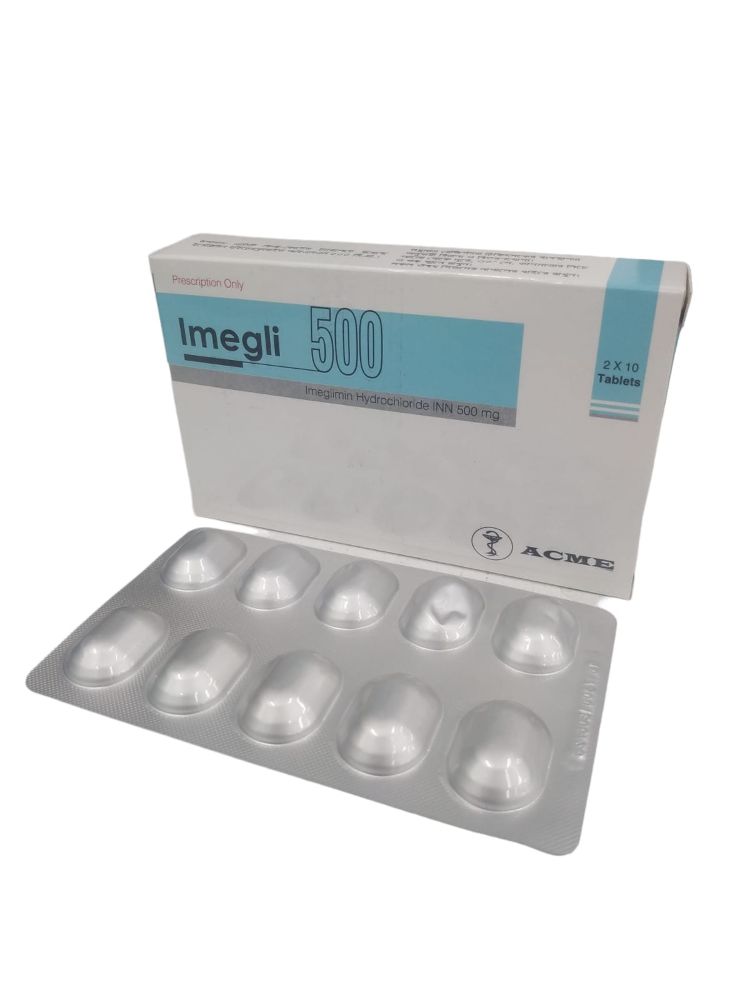
Type:10 Tablets
Generic Name:Imeglimin Hydrochloride
Manufacturer:The ACME Laboratories Ltd.
Price:৳200.00
"Type 2 diabetes mellitus".
Should be taken orally with food.
The usual adult dosage is 1000 mg of _NAME_ administered orally twice daily in the morning and evening.
Not recommended.
It is safe to use in patients with kidney disease. No dose adjustment is recommended.
Acute or chronic metabolic acidosis with or without coma (including diabetic ketoacidosis). Renal failure, severe renal or hepatic impairment, acute conditions which may affect renal function e.g. dehydration, severe infection or shock. Cardiac failure, CHF, IDDM, severe impairment of thyroid function; acute or chronic alcoholism. Acute or chronic diseases which may cause tissue hypoxia e.g. cardiac or respiratory failure, recent MI or shock. Pregnancy, lactation.
_NAME_ mechanism of action involves dual effects: (a) amplification of glucose-stimulated insulin secretion (GSIS) and preservation of β-cell mass; and (b) enhanced insulin action, including the potential for inhibition of hepatic glucose output and improvement in insulin signalling in both liver and skeletal muscle. At a cellular and molecular level, Imeglimin's underlying mechanism may involve correction of mitochondrial dysfunction, a common underlying element of T2D pathogenesis. It has been observed to rebalance respiratory chain activity (partial inhibition of Complex I and correction of deficient Complex III activity), resulting in reduced reactive oxygen species formation (decreasing oxidative stress) and prevention of mitochondrial permeability transition pore opening (implicated in preventing cell death). In islets derived from diseased rodents with T2D, _NAME_ also enhances glucose-stimulated ATP generation and induces the synthesis of nicotinamide adenine dinucleotide (NAD+) via the 'salvage pathway'. In addition to playing a key role as a mitochondrial co-factor, NAD+ metabolites may contribute to the increase in GSIS (via enhanced Ca++ mobilization)._NAME_ has also been shown to preserve β-cell mass in rodents with T2D. Overall, _NAME_ appears to target a key root cause of T2D: defective cellular energy metabolism. This potential mode of action is unique and has been shown to differ from that of other major therapeutic classes, including biguanides, sulphonylureas and glucagon-like peptide-1 receptor agonists.
Caution when used in patients with CHF especially in those with unstable or acute heart failure. Risk of lactic acid accumulation increases with the degree of renal impairment. May need to discontinue treatment in patients with stress-related states e.g. fever, trauma, infection or surgery. _NAME_ should be temporarily discontinued for 48 hr in patients undergoing radiologic studies involving intravascular admin of iodinated contrast materials. Elderly. Monitor renal function regularly.
Most side effects do not require any medical attention and disappear as your body adjusts to the medicine. Consult your doctor if they persist or if you’re worried about them Common side effects of _NAME_ Hypoglycemia (low blood glucose level) Constipation.
Uncontrolled diabetes during pregnancy (gestational or permanent) is associated with an increased risk of congenital abnormalities and perinatal mortality. When the patient plans to become pregnant and during pregnancy, it is recommended that diabetes is not treated with _NAME_ but insulin be used to maintain blood glucose levels as close to normal as possible, to reduce the risk of malformations of the foetus.
Additive effect with _NAME_ . Thiazide diuretics, corticosteroids, phenothiazines, OC, sympathomimetics, niacin, Ca channel blockers and isoniazid may exacerbate loss of glycaemic control. ACE inhibitors may reduce fasting blood glucose concentrations. May increase serum level w/ cimetidine. Potentially Fatal: Concurrent use w/ iodinated contrast agents may increase the risk of metformin-induced lactic acidosis.